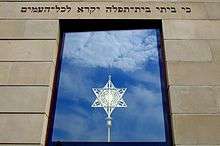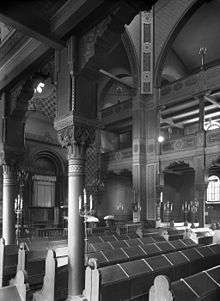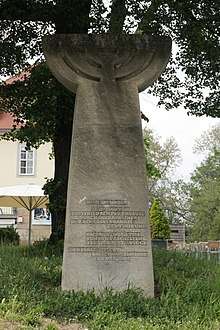Semper Synagogue
The Semper Synagogue, also known as the Dresden Synagogue, designed by Gottfried Semper and built from 1838 to 1840, was dedicated on 8 May 1840.[1] It was an early example of the Moorish Revival style of synagogue architecture.
.png)

History and destruction
The synagogue was destroyed in 1938 on Kristallnacht. Members of the SA and SS burned down the synagogue on the night of 9 November 1938, almost one hundred years after the opening of the synagogue. A few days after the burning, the ruins were carried away "professionally" and the bill to cover these costs was handed to the Jewish congregation. A film made by the "Technischen Hilfswerk" documented the efficient removal of the building.[2] All that remains of the synagogue is the Star of David which was designed by Semper, which Alfred Neugebauer, a fireman, removed from the burning rooftop, hid and returned to the congregation in 1949.
Architecture
Interior

While the exterior was Romanesque, its interior featured the richly ornamented style that was to become the hallmark of Moorish Revival architecture. The elaborate Arabic-style interior had a two-tiered balcony supported by columns copied from the Alhambra. The arches and balcony fronts were richly worked with intricate polychrome foliate and lattice designs in the Moorish style.[3] According to Harry Frances Mallgrave, most of the ornaments "were painted on the plaster surfaces in imitation of more costly materials."[4]
Exterior
The synagogue was situated along the old city ramparts, along the river, some five hundred meters from the new theatre (known as the Semperoper) that Gottfried Semper was constructing at the same time he built the synagogue. The building was purposely designed to be modest, as Chief Rabbi Dr Zacharias Frankel said at the opening ceremony: "we were not driven by the desire to brag with an opulent building; rather we wanted to find an appropriate place of worship, (...) where we show ourselves before God in devout communion."[5] The synagogue was a plain cube structure, built in a Romanesque style with a humble vestibule and twin towers that marked the entrance to the building.
Eternal light
The interior design included furnishings - all designed by Semper, who considered each project as a Gesamtkunstwerk.[6] For the synagogue he created a Ner Tamid - silver lamp of eternal light, placed before the Torah scrolls,[7] which caught Richard Wagner and his wife Cosima's fancy. They gave a great deal of effort to procure a copy of this lamp.[8][9]
Historical importance

Semper was the first architect to borrow the Moorish iconography for a synagogue. His countless imitators and followers include Semper's student Otto Simonson, who would construct the magnificent Moorish Revival Leipzig synagogue in 1855, and Adolf Wolff[10], who built the Great Synagogue of Łódź and synagogues in Nürnberg, Stuttgart, Helbronn and Ulm. Many other architects of the late 19th century followed the style of this synagogue.
New Synagogue
The New Synagogue, inaugurated in 2001, was erected next to the site of the Semper synagogue where a monument showing a six branch menorah stands in memory of the six million Jews murdered by the Nazis.
References
- German Jewry and the Allure of the Sephardic, by John M. Efron
- Hartmut Ellrich, Dresden 1933-1945, Der historische Reiseführer Ch. Links Verlag, 2008 pp. 4-7
- Harold Alan Meek, The Synagogue, Phaidon, London, 1995, p. 188, includes photo of interior
- Gottfried Semper, Architect of the nineteenth century, Harry Frances Mallgrave, Yale, 1996, P.100
- speech by Dr. Frankel: Die Heiligung des Gotteshauses. Dresden, Königlichen Hofbuchdruckerei, 1840
- Barbara von Orelli Messerli "Gottfried Semper, die Entwürfe zur dekorativen Kunst", Petersberg, 2010
- Gottfried Semper ... Der Stil in den technischen u. tektonischen Künsten
- Colin Eisler "Wagner's Three Synagogues", Artibus et Historiae 2004, Vol. 25/Nr. 50
- Eytan Pessen, Zusammenhängende Reliquien, eine Geschichte über Richard Wagner und Gottfried Semper, pp. 1-22, Semperoper Dresden, Erchien in Wagnerjahr 2013, Spielzeit 2012-2013 & 2013-2014
- List of Jewish architects
External links
| Wikimedia Commons has media related to Alte Synagoge, Dresden. |
- The Semper Synagogue, Pictures
- Fancis Morrone, Moorish Influence At Home in the City New York Sun, December 15, 2006